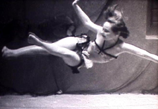 |
||||
Still from Severing the Soul (dir. Barbara Klutinis, 2008) Used with permission from Barbara Klutinis. |
||||
Journal Issue 2.supplement
Summer 2010
Edited by Deanna Utroske, Agatha Beins, Karen Alexander, Julie Ann Salthouse, and Jillian Hernandez
Managing Editor: Katherine O’Connor
A Portal to Dream Worlds: Experimental Film in the Community College Classroom
Essay by Barbara Klutinis
In introducing experimental film to community college students, one has to circumvent the bias of a video-game mindset, Hollywood’s computer-generated imagery (CGI) extravaganzas, and numbingly predictable narratives. In my sixteen years of teaching experimental film as part of a college class in general film appreciation, I found that if I could give the students an analytical toolkit they would find experimental films more accessible and begin to understand them. We explored many concepts, including reconstructed narratives, repetition and metaphor, dream imagery, manipulated time and space, and hand-manipulated celluloid. One of the more useful concepts was the dream world, specifically how experimental films allow us to access that world through a variety of portals.
Since Maya Deren has inspired so many women experimental filmmakers, I often used her A Study in Choreography for the Camera (1945) to introduce the students to a basic editing concept, the match on action, to illustrate how editors use this tool to carry viewers from one space to another, seamlessly, in conventional cinema. I would follow with the seminal experimental film Un Chien Andalou (Luis Buñuel and Salvador Dalí 1929). The eye-slitting scene and its match on action got their attention, but I emphasized that in this film match on action was used to carry the viewer into illogical space, the space of dreams. The misleading title cards, spatial ambiguities, and fluid identities are further benchmarks of the dream state. The film also illustrates how one could infuse a creative work with antisociety, antireligion, and anticonformity messages without stating them directly. To prepare students for the film, I would give a brief exercise in free association, a Freudian portal of dreams, which set the mood for the free associations in Un Chien Andalou.
I usually followed this film with Deren’s Meshes of the Afternoon (1943). The students frequently responded more warmly to this film since its dream space was more apparent in the endless variations on a theme, mimicking the repetitive nature of the mind. I would point out Deren’s use of cutting on action across disjunctive spaces, her changes in perspective, and the growing power of symbolism—all the stuff of dreams.
To illustrate other aspects of experimental film, I often screened Pools (1981), the film I made with Barbara Hammer, as an example of how a filmmaker could put the viewer in the middle of the action to let the viewer create her own experience. Another Hammer film, Our Trip (1980), a playful single-frame animation constructed from postcards, fruits and vegetables, and photos from Hammer’s trip to Machu Picchu, showed the students that experimental film needn’t always be somber, inward searching, and inaccessible.
Jay Rosenblatt’s The Smell of Burning Ants (1994) often resonated with the students in these classes. The young men, in particular, found a common ground with the notions of taunting small creatures, social tyranny, bullying, and male conditioning in this film. I would explain how the dream space of this film was constructed from reclaimed and reappropriated images and how the filmmaker crafted these found images into his own lessons.
Louise Bourque’s The People in the House (1994) uses a fractured narrative and voiceover excerpts from the Catholic catechism to explore dysfunctional family dynamics in a household she reconstructed from memory, fantasy, and dream. Again, dream imagery figures heavily in this disturbing celluloid depiction of tension between harmony and chaos. The film was constructed from hand-colored 35 mm. film negative, which visually suggests memory and dream states.
Another successful film was Eva Brzeski’s 24 Girls (1998), a film about absence and loss. The film begins with an audition of prepubescent girls but soon morphs into a reminiscence about one missing girl who died in the fourth grade. The narration pulls the audience deeper into Brzeski’s world of night journeys, half-memories, and foreshadowings of whom the absent girl might have become. The haunting and nostalgic quality of the film and its dreamlike imagery seemed to touch the students on a deep level.
In the end, I don’t know how many community college students I converted to experimental film, but I had the satisfaction of knowing that I had at least broadened their horizons around the art and craft of filmmaking and given them access to films they might never have seen.
Barbara Klutinis (klubarb@gmail.com) is a retired teacher of film studies at Skyline College and San Francisco State University. Although her early films are hand-colored, optically printed 16 mm. experimental films, she is currently exploring documentary films and video. Her films have screened in the United States, Europe, South America, Mexico, Canada, and Japan. Barbara Klutinis’s filmography includes Pools (1981 coproduced with Barbara Hammer), Wind/Water/Wings (1995), and Stepping into the Stream (2010).
Copyright © 2014. All rights reserved.